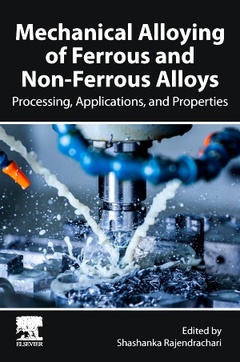Mechanical Alloying of Ferrous and Non-Ferrous Alloys Processing, Properties, and Applications
Langue : Anglais
Coordonnateur : Rajendrachari Shashanka

Mechanical Alloying of Ferrous and Non-Ferrous Alloys: Processing, Applications, and Properties provides an in-depth exploration of ferrous and non-ferrous alloys, including various methods of preparation and production, their mechanical properties, and applications. The advantages of the mechanical alloying processing approach over other traditional powder metallurgical techniques is explained as are the alloys that are best suited for this technique. Preparation steps, microstructures, properties, and applications for ferrous and non-ferrous alloys are compared, with insights on which alloys are best suited for preparation by alloying.
The advantages and disadvantages of wet and dry milling are outlined. Processing, properties, and applications of high entropy alloys, ODS stainless steel, shape memory alloys, cermets, iron, copper, zinc, tungsten, aluminum, titanium, magnesium, and ceramic-based alloys are also covered, as are different powder preparation techniques and sintering methods.
The advantages and disadvantages of wet and dry milling are outlined. Processing, properties, and applications of high entropy alloys, ODS stainless steel, shape memory alloys, cermets, iron, copper, zinc, tungsten, aluminum, titanium, magnesium, and ceramic-based alloys are also covered, as are different powder preparation techniques and sintering methods.
1. Evolution of Mechanical alloying
2. Types of ball milling and their mechanism
3. Overview of the dry milling vs. wet milling
4. Comparative study of mechanical alloying and other conventional powder metallurgical methods
5. Consolidation of mechanically alloyed powders
6. Secondary Processing of Sintered Compacts
7. How mechanical alloying facilitated the fabrication of tungsten heavy alloys
8. Fabrication of Cermets and Copper Alloys by Ball Milling and Investigation of their Properties and Applications
9. Processing of Titanium alloys by mechanical alloying
10. How mechanical alloying facilitated the preparation of intermetallic, ceramic, shape memory alloys, and high entropy alloys?
11. Role of Mechanically Alloyed Materials in Energy Storage and Automotive Applications
12. Current and Future Applications of mechanically alloyed materials
2. Types of ball milling and their mechanism
3. Overview of the dry milling vs. wet milling
4. Comparative study of mechanical alloying and other conventional powder metallurgical methods
5. Consolidation of mechanically alloyed powders
6. Secondary Processing of Sintered Compacts
7. How mechanical alloying facilitated the fabrication of tungsten heavy alloys
8. Fabrication of Cermets and Copper Alloys by Ball Milling and Investigation of their Properties and Applications
9. Processing of Titanium alloys by mechanical alloying
10. How mechanical alloying facilitated the preparation of intermetallic, ceramic, shape memory alloys, and high entropy alloys?
11. Role of Mechanically Alloyed Materials in Energy Storage and Automotive Applications
12. Current and Future Applications of mechanically alloyed materials
Dr. Shashanka Rajendrachari obtained his PhD in powder metallurgy from the Department of Metallurgical and Materials Engineering, National Institute of Technology Rourkela, India. He earned his M.Sc. in Industrial Chemistry and his M.Tech. in Nanoscience and Technology degrees from Kuvempu University in Karnataka, India. He was the first recipient of the prestigious Powder Metallurgy Student of the Year award given by the Powder Metallurgy Association of India in 2015 at IIT Bombay. At the recent 4th International Scientist Awards celebration on Engineering, Science, and Medicine held in Chennai, India, he was honored as the "Young Scientist-2020." Additionally recognized as the "Young Achiever of the Year-2020" at the PERFICIO AWARDS-2020 in New Delhi, India by the DHS Foundation, New Delhi, India, and CAMPBELL University, North Carolina, USA. According to Stanford University in the United States and published by Elsevier, his name is listed among the top 2% of scientists in the world for the year 2020.
He has experience with the mechanical alloying approach to generate nanostructured stainless-steel powders, high entropy alloys, and shape memory alloys. He has 7.5 years of combined research and teaching experience, and he has published 41 research articles, 4 books, and 4 book chapters in various international peer-reviewed journals. His research areas include corrosion, electrochemical sensors, mechanical alloying, and nanomaterials.
He has experience with the mechanical alloying approach to generate nanostructured stainless-steel powders, high entropy alloys, and shape memory alloys. He has 7.5 years of combined research and teaching experience, and he has published 41 research articles, 4 books, and 4 book chapters in various international peer-reviewed journals. His research areas include corrosion, electrochemical sensors, mechanical alloying, and nanomaterials.
- Outlines the different types of mechanical alloying used to prepare powders, their mechanisms, factors affecting the process, and more
- Covers the manufacturing, characteristics, and applications of high entropy alloys, ODS stainless steel, shape memory alloys, magnesium, ceramic-based alloys, and more
- Compares preparation of ferrous and non-ferrous alloys, their microstructures, and properties
- Discusses the advantages and disadvantages of wet and dry milling
Date de parution : 07-2024
Ouvrage de 364 p.
15x22.8 cm
Thème de Mechanical Alloying of Ferrous and Non-Ferrous Alloys :
© 2024 LAVOISIER S.A.S.



